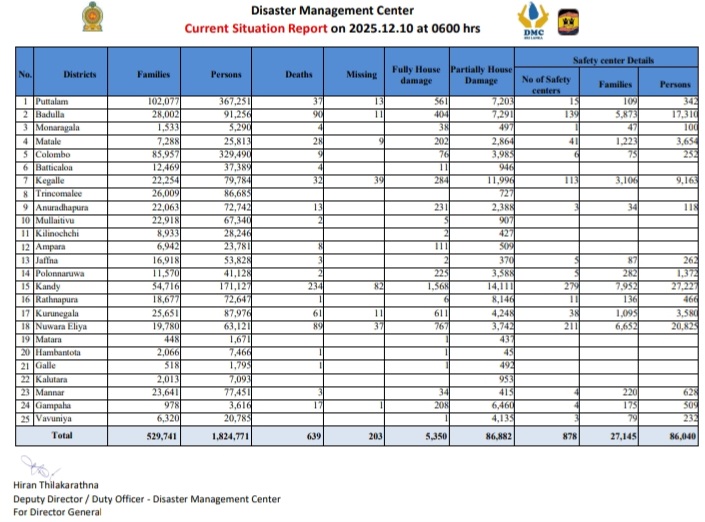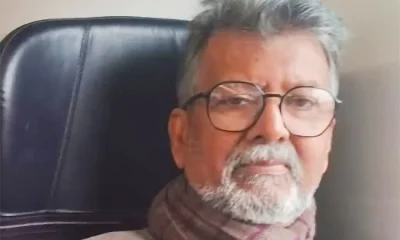Latest News
Latham, Williamson fifties extend New Zealand’s advantage
Partnerships were the name of the game as New Zealand strung together several of significance to come within 50 runs of Sri Lanka’s first-innings total of 305 at stumps on day two in Galle.
There were breezy fifties from Tom Latham and Kane Williamson and Rachin Ravindra also put forward an aggressive cameo. By the time an extended final session ended 15 minutes early due to bad light, there were more names on that list, as Daryl Mitchell and Tom Blundell had put together an unbeaten stand of 59 off 105. Theirs was the fourth 50-plus stand of the innings on a day that belonged almost in totality to the visitors.
All this happened despite a rain-curtailed morning session during which only 15 minutes of play were possible. But that was all it took for New Zealand to pick up the remaining three Sri Lanka wickets.
Sri Lanka’s best moments of the day were just that – moments – as their bowlers struggled to put together any periods of concerted pressure. Despite the surface offering turn, none of the four spinners used by the hosts were able to find consistent lines and lengths – either due to the strong breeze across the stadium or the New Zealand batters’ proactiveness in using their feet as well as a variety of sweeps.
The hosts were also unable to build on any of the wickets to fall, with each new batter settling in quickly. Only a burst from Dhananjaya de Silva when he dismissed Williamson and Ravindra in the space of two overs, offered a glimmer of Sri Lankan dominance, but that hope was snuffed out quickly by Mitchell and Blundell.
The rest of the spinners’ figures told a story. Prabath Jayasuriya toiled for 31 overs for figures of 99 for 1, easily his worst in Galle thus far, while Ramesh Mendis’ 17 overs went for 69 and brought a solitary scalp. Kamindu Mendis was used only for one over that went for eight.
Earlier in the day, it was Latham and Williamson who proved to be Sri Lanka’s tormentors. Latham, in particular, provided the blueprint during his 111-ball 70, both with his footwork and, more potently, prolific use of the sweep and reverse sweep.
While Devon Conway never really looked anywhere close to his flowing best, labouring his way to 17 off 59 deliveries, Latham was more than making up for it at the other end. This ensured a solid opening stand of 63, one brought to an end against the run of play – and upon review – with Conway missing one from Ramesh Mendis that straightened after pitching.
Instead of bringing Sri Lanka back into proceedings, the wicket only hastened New Zealand’s advancement as Williamson easily matched Latham’s urgency. Within his first 14 deliveries, the former captain had cut, pulled and lofted two boundaries and a six, and while that rate of scoring was never going to be maintained, the Sri Lanka spinners’ wayward lines allied with expert manoeuvring from both Williamson and Latham meant dot balls were rarely strung together.
That Sri Lanka eventually broke the 73-run stand, which took only 120 balls, was down to the batter’s error more than the bowlers’ effectiveness, as Latham’s most potent weapon – the sweep – became his undoing, when he top-edged to backward square leg off Jayasuriya at the stroke of tea.
There was no respite for Sri Lanka in the final session either, as Ravindra managed to further up the ante over the course of a 48-ball 39. His expert use of the depth of the crease also meant any error in length was punished square of the wicket on either side.
The Williamson-Ravindra stand of 51 took just 84 deliveries, and were it not for a piece of brilliance from wicketkeeper Kusal Mendis – leaping forward past the stumps to hold on to a leading edge of Williamson – it was hard to see where a breakthrough might have come from. Ravindra himself fell shortly after, leaving an arm ball that clattered into his off stump and punching his bat in disgust on the way back to the dressing room. But Sri Lanka’s joy was short-lived as Mitchell and Blundell negotiated safely whatever was thrown at them, including a period of short-ball barrages from Asitha Fernando.
During the heavily rain-affected morning session, William O’Rourke starred once more, adding two further wickets to his overnight tally, to end with figures of 5 for 55 as Sri Lanka were bowled out adding just three runs to their overnight total.
Brief scores:
New Zealand 255 for 4 in 72 overs (Tom Latham 70, Kane Williamson 55, Dhananjaya de Silva 2-31) trail Sri Lanka 305 (Kamindu Mendis 114, Kusal Mendis 50, William O’Rourke 5-55) by 50 runs
(Cricinfo)
Latest News
India extends multi-front support to Sri Lanka’s cyclone relief efforts

India has strengthened its humanitarian support to Sri Lanka in the aftermath of Cyclone Ditwah, providing critical air assets, emergency supplies, engineering equipment and medical aid to bolster national rescue and recovery operations.
India dispatched an additional MI-17 helicopter to assist the Sri Lanka Air Force (SLAF) in ongoing air rescue missions on Tuesday (09). Two MI-17 V5 helicopters of the Indian Air Force had been operating in Sri Lanka from 29 November, conducting around 90 sorties, rescuing approximately 270 survivors, airlifting about 50 tonnes of relief material to inaccessible areas and relief camps and deploying 57 Sri Lankan troops to cut-off locations.
Having completed their flying hours, the two helicopters returned to India on Sunday (08) for mandatory maintenance and a fresh MI-17 aircraft arrived at Katunayake Airport to continue operations alongside the SLAF.
The aviation support comes alongside major maritime assistance. The Indian naval vessel INS Gharial arrived at the Port of Trincomalee on Sunday (08) carrying a 700-tonne humanitarian shipment, marking India’s fifth naval relief consignment to Sri Lanka, apart from 10 aircrafts and 5 helicopters, which have contributed towards rescues and relief operations, since the cyclone.
The shipment included essential food supplies such as pulses, sugar and milk powder, as well as bed sheets, towels, sarees, dhotis and tarpaulins for families displaced by flooding and landslides. The emergency aid is being directed to the hardest-hit districts through local relief agencies.
In a further show of engineering support, India has also handed over a 63-ton Bailey bridge and a consignment of essential medicines to Sri Lankan authorities to restore connectivity and meet urgent medical needs in affected communities.
The cargo was received by General Chaminda Wijerathne of the Sri Lanka Army Headquarters, Sunil Jayaweera, former Director Preparedness of the Disaster Management Centre (DMC), now volunteering in the response and Shan Pathirana, Deputy Director of the DMC Awareness Division.
The handover was facilitated by the Indian High Commission in Colombo.
These coordinated air, sea and engineering initiatives underscore India’s continued commitment to supporting Sri Lanka during its national emergency response and long-term recovery. The assistance forms part of India’s broader partnership to restore essential services, reconnect isolated communities and provide relief to thousands affected by Cyclone Ditwah.
Latest News
639 deaths reported as at 0600AM today [10th]

The Situation Report issued by the Disaster Management Center [DMC] confirms that as at 06:00AM today [10th December 2025] 639 persons have lost their lives to floods and landslides that devastated Sri Lanka in the past few days. The number of missing persons reported was 203.
The adverse weather conditions had affected 1.824,771 persons of which 86,040 were being taken care at 878 safety centers established by the government. 5,350 houses had been completely damaged while 86.882 houses had been partially damaged.

Latest News
Level III landslide warnings issued to the Districts of Kandy, Kegalle, Kurunegala and Matale extended

The Level III RED landslide early warnings issued to the Districts of Kandy, Kegalle, Kurunegala and Matale by the Landslide Early Warning Center of the National Building Research Organisation [NBRO] have been extended until 1600hrs tomorrow [10th December 2025].
Accordingly,
The LEVEL III RED landslide early warnings issued to the Divisional Secretaries Division and surrounding areas of Panvila, Udapalatha, Minipe, Poojapitiya, Gangawata Korale, Thumpane, Doluwa, Pathadumbara, Ganga Ihala Korale, Harispattuwa, Akurana, Ududumbara, Pathahewaheta, Hatharaliyadda, Yatinuwara, Deltota, Medadumbara, Udunuwara, Kundasale and Pasbage Korale in the Kandy district, Yatiyanthota, Rambukkana, Aranayaka, Warakapola, Galigamuwa, Mawanella and Bulathkohupitiya in the Kegalle district, Mallawapitiya, Rideegama and Mawathagama in the Kurunegala district, and Ukuwela, Pallepola, Rattota, Matale, Laggala Pallegama, Yatawatta, Naula, Ambanganga Korale and Wilgamuwa in the Matale district have been extended.
LEVEL II AMBER landslide early warnings issued to the Divisional Secretaries Division and surrounding areas of Uva Paranagama, Hali_Ela, Meegahakivula, Badulla, Kandeketiya, Bandarawela, Soranathota, Ella, Haputhale, Lunugala, Welimada, Haldummulla and Passara in the Badulla district, Ruwanwella, Dehiowita, Kegalle and Deraniyagala in the Kegalle district, Alawwa and Polgahawela in the Kurunegala district and Nuwara Eliya, Nildandahinna, Thalawakele, Kothmale West, Mathurata, Ambagamuwa Korale, Hanguranketha, Walapane, Kothmale East and Norwood in the Nuwara Eliya district, and Kahawaththa, Kolonna and Godakawela in the Ratnapura district have also been extended.
LEVEL I YELLOW landslide early warnings issued to the Divisional Secretaries Divisions and surrounding areas of Mirigama, Divulapitiya and Attanagalla in the Gampaha district, Narammala in the Kurunegala district, and Kiriella, Balangoda, Kuruwita, Openayake, Nivithigala, Kaltota, Pelmadulla, Kalawana, Eheliyagoda, Elapatha, Ayagama, Imbulpe and Ratnapura in the Ratnapura district.
-

 News2 days ago
News2 days agoOver 35,000 drug offenders nabbed in 36 days
-

 News6 days ago
News6 days agoLevel III landslide early warning continue to be in force in the districts of Kandy, Kegalle, Kurunegala and Matale
-

 Business4 days ago
Business4 days agoLOLC Finance Factoring powers business growth
-

 News4 days ago
News4 days agoCPC delegation meets JVP for talks on disaster response
-

 News4 days ago
News4 days agoA 6th Year Accolade: The Eternal Opulence of My Fair Lady
-

 News2 days ago
News2 days agoRising water level in Malwathu Oya triggers alert in Thanthirimale
-

 News1 day ago
News1 day agoCyclone Ditwah leaves Sri Lanka’s biodiversity in ruins: Top scientist warns of unseen ecological disaster
-

 Latest News4 days ago
Latest News4 days agoLandslide RED warnings continue to be in force for the Districts of Kandy, Kegalle, Kurunegala, Matale and Nuwara Eliya













